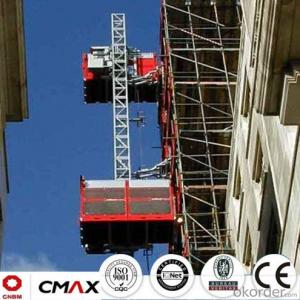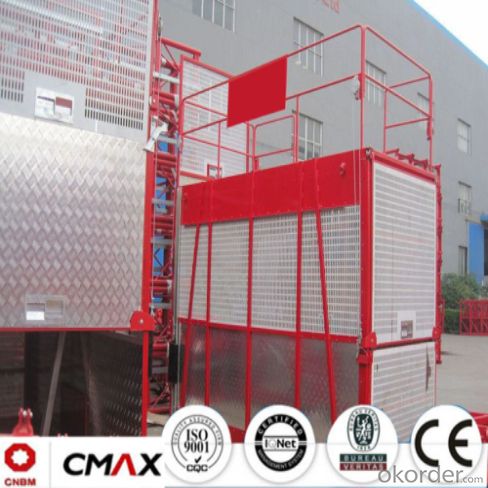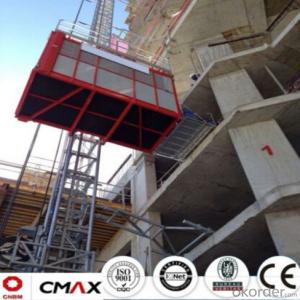Building Hoist Hot Galvanizing Mast Section Spare Parts with 2ton Capacity
- Loading Port:
- China main port
- Payment Terms:
- TT OR LC
- Min Order Qty:
- 1 unit
- Supply Capability:
- 5 unit/month
OKorder Service Pledge
OKorder Financial Service
You Might Also Like
Structure of Building Hoist Description
1.The gearing select perfect bearing,strong cables and oil seal.
2.The electrical parts select products from famous world manufacturers for example Schneider,Siemens and LG.
3.The racks and pinion select advanced material and advanced technique,which enhance the life of all parts.
4.The steel structure adopted strong steel from famous native manufacturers.
5.The surface of the steel structure can adopt paint-spray,parkerizing baking finish or hot galvanizing processing depending on users requirement.
6.The cage can be made and decorated by aluminum molded board,punched-plate or figured aluminum board.
Packaging & Delivery of Building Hoist
Packaging: nude and wooded box Delivery: 25-30days
Mains Parts of Building Hoist
1.The steel structure for example the mast, tie in and cabin ,could be all spay-painted and hot galvanized. Mast section is made with high quality Q345B which is the top standared in China.
2.Electrical parts are all adopted with Schneider , Siemens and other famous brands.
3.The electrical system can be selected with the normal control method and VVVF+PLC control way. Inverter we selected is from Schneider. Yaskawa or other world renowned brand.
4.Cabin exit door select ramping type. The ramping door looks like a bridge between the construction hoist and construction building.
5.The cabin floor is made from 3MM thickness steel riffled board(Hot dip galvanized), and 15MM thickness wooden board which can reduce the vibration and deformation a lot.
6.Driving unit is adopted the products from ZHANGJIANG and other reputed maker, or from SEW, NORD.
7.Safety system is mainly composed of electrical motor braking, anti-drop safety device, top & bottom limit switches, top & bottom 3-phase switches, door limit switches, buffer device and over-load protection. The system aims to ensure the hoist are running safely.
8.Qualification: CE, ISO9001:2008 and etc.
9.The long-term operation of CMAX building hoists testifies CMAX hoist is working performance is stable.
Building Hoist Images



Building Hoist Specification

FAQ of Building Hosit
Q: What is the building hoist main purpose?
A: Building hoist equipped with double or single cabin to transport the materials and labors up and down. It's the ideal construction equipment for vertical transportation in the field of construction.
Q: What is the main structure of building hoist?
A: The P/M construction hoist mainly contains metal structure, driving system, electrical control system, cable guide & protection system, electrical top crane and safety device.
Q: What is the meaning of the building hoist’s code?
A: Take SC200/200 for example: “SC” stands for rack and pinion hoist, “200/200” stands for double cage and capacity is 2 tons per cage. “SC200” stands for single cage and capacity is 2 tons.
Q: What is the dimension of the cage?
A: Normally the cage dimension is 3X1.5X2.5M (L/W/H) for 2t type hoist. Details should be checked according to our
quotation sheet. Also, the size can be customized according to the factual site condition. There are two doors (entrance& exit doors) for each cage, It can be produced as up & down sliding or ramping model for safety and convenience.
- Q: Is it possible to utilize building hoists in environments with high altitudes?
- <p>Yes, building hoists can be used in high-altitude environments, but their performance may be affected. At high altitudes, reduced air density can lead to decreased efficiency in hoist operations, particularly those powered by combustion engines. It's crucial to select hoists designed for high-altitude use, which may include features such as high-altitude ignition systems and special lubricants. Additionally, regular maintenance and adjustments to the hoist's operation parameters are necessary to ensure safety and optimal performance.</p>
- Q: Is it possible to use a lifting device to assist in lifting a person who is too heavy to lift manually?
- <p>Yes, lifting devices such as hoists or mechanical lifts can be used to safely lift someone who is too heavy to lift manually. These devices are designed to support the weight and reduce the risk of injury to both the person being lifted and the caregiver. It's important to use the appropriate equipment for the individual's weight and to follow safety guidelines and manufacturer's instructions to ensure proper and secure lifting.</p>
- Q: This question asks for an explanation on how to operate a winch, specifically in the context of a building hoist.
- <p>To use a winch, particularly a building hoist, follow these steps: Ensure the winch is securely anchored and the cable is in good condition. Attach the load to the hook, ensuring it's balanced. Turn the winch handle clockwise to lift the load; counterclockwise to lower it. Always keep tension on the cable to prevent it from slacking. Use a tag line to guide the load horizontally. Never exceed the winch's load limit. Regularly inspect the winch and cable for wear and tear. Always have a spotter to assist and communicate during the operation. Safety is paramount, so never leave the winch unattended while the load is in the air.</p>
- Q: Is it possible to use a building hoist for lifting light objects without any additional tools?
- <p>Yes, a building hoist can be used for lifting light objects without using any tools. Building hoists are designed to lift a variety of materials, including lighter items, within their weight capacity. However, it's crucial to ensure that the hoist is rated for the weight of the object and that safety protocols are followed to prevent accidents. Always consult the hoist's manual for specific guidelines on weight limits and safe operation procedures.</p>
- Q: This question asks about the procedures and practices for regularly maintaining and inspecting a building hoist to ensure its safe and efficient operation.
- <p>Regular maintenance and inspection of a building hoist are crucial for safety and efficiency. It involves daily checks before use, including visual inspections for any visible damage, proper functioning of safety devices, and ensuring the hoist is clean and free of debris. Weekly inspections should focus on the mechanical components, such as gears, cables, and brakes, and checking for any unusual noises or vibrations. Monthly inspections may include more in-depth checks of the electrical systems and the structural integrity of the hoist. Annual inspections typically involve a thorough examination by a certified professional, who will assess the overall condition and safety of the hoist, ensuring it complies with all relevant safety standards. Always follow the manufacturer's guidelines and local regulations for maintenance and inspection schedules.</p>
- Q: Explain the benefits and drawbacks of using an electric winch compared to a building hoist.
- <p>Advantages of using an electric winch include ease of operation, lower noise levels, and the ability to be used in various environments. They are also more portable and can be easily moved between different locations. Disadvantages include higher initial costs compared to some building hoists, potential electrical hazards, and the need for regular maintenance to ensure safety. Additionally, electric winches may have lower lifting capacities compared to some building hoists, which could be a limitation for heavy construction tasks.</p>
- Q: What measures should be taken to ensure safety when operating electric-motor powered building hoists?
- <p>When using electric-motor type building hoists, safety precautions include: ensuring all safety devices are in good working order, regularly inspecting and maintaining the hoist, following the manufacturer's guidelines, never overloading the hoist, keeping the hoist and its surroundings clean and free from obstructions, using proper lifting techniques, ensuring the hoist is stable and secure, wearing appropriate personal protective equipment, and training operators on the safe use of the hoist. Adhering to these precautions can significantly reduce the risk of accidents and ensure the safety of workers and the integrity of the construction process.</p>
- Q: What steps are necessary to guarantee the safety and reliability of a building hoist?
- <p>To ensure a building hoist is safe and reliable for use, follow these steps: Conduct regular inspections and maintenance by qualified personnel. Check all mechanical and electrical components for wear and tear. Ensure all safety features, such as emergency stop buttons and limit switches, are functioning correctly. Verify that the hoist is properly secured to the building and that all load-bearing elements are capable of handling the weight. Adhere to the manufacturer's guidelines and specifications for operation. Train operators on the proper use of the hoist and emergency procedures. Regularly test the hoist's load capacity and stability. Keep records of all inspections, maintenance, and any incidents for future reference.</p>
- Q: What are alternative uses for a building hoist besides construction?
- <p>Yes, a building hoist can be used for purposes other than construction. It can be utilized for moving heavy equipment in industrial settings, transporting goods in warehouses, or even in emergency services for rescue operations. Its ability to lift and lower heavy loads makes it versatile for various applications where vertical transportation is required. However, it's crucial to ensure that any alternative use complies with safety regulations and the hoist's operational specifications.</p>
- Q: There are differences between the construction elevator and the construction elevator
- When it comes to the construction elevator, people will immediately think of construction lifter, the construction elevator and elevator is just a different name or have their own respective working principle? By below small make up to you to introduce: construction elevator is often referred to as construction lifter, but construction lifter, including the definition of a broader platform construction also belongs to the construction lifter series.
Send your message to us
Building Hoist Hot Galvanizing Mast Section Spare Parts with 2ton Capacity
- Loading Port:
- China main port
- Payment Terms:
- TT OR LC
- Min Order Qty:
- 1 unit
- Supply Capability:
- 5 unit/month
OKorder Service Pledge
OKorder Financial Service
Similar products
Hot products
Hot Searches
Related keywords
































